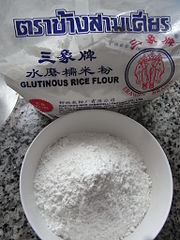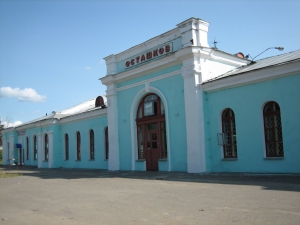Рисовая мука. Мука рисовая википедия
Рисовая мука — Википедия
Материал из Википедии — свободной энциклопедии

Рисовая мука — тип муки, произведённый из зёрен риса. Она отличается от рисового крахмала, который обычно получают путём вымачивания риса в щёлоке. Такую муку часто используют в национальных кухнях стран юго-восточной Азии: в японской, корейской, тайской, вьетнамской, индийской. Рисовая мука также используется в качестве загустителя в продуктах, которые хранятся в охлажденном или замороженном виде, поскольку она сдерживает разделение жидкостей.
- Полуфабрикаты и блюда из рисовой муки
-
Японский рисовый хлеб
-
Рисовая лапша
Ссылки
wikipedia.green
Рисовая мука — Википедия
Материал из Википедии — свободной энциклопедии

Рисовая мука — тип муки, произведённый из зёрен риса. Она отличается от рисового крахмала, который обычно получают путём вымачивания риса в щёлоке. Такую муку часто используют в национальных кухнях стран юго-восточной Азии: в японской, корейской, тайской, вьетнамской, индийской. Рисовая мука также используется в качестве загустителя в продуктах, которые хранятся в охлажденном или замороженном виде, поскольку она сдерживает разделение жидкостей. 1 стакан рисовой муки (200 мл.) тяжелее пшеничной и весит 140 г., а не 130 как стакан пшеничной.
- Полуфабрикаты и блюда из рисовой муки
-
Японский рисовый хлеб
-
Рисовая лапша
ru.bywiki.com
Рисовая мука — Википедия © ru.wikipedia.org
Материал из Википедии — свободной энциклопедии

Рисовая мука — тип муки, произведённый из зёрен риса. Она отличается от рисового крахмала, который обычно получают путём вымачивания риса в щёлоке. Такую муку часто используют в национальных кухнях стран юго-восточной Азии: в японской, корейской, тайской, вьетнамской, индийской. Рисовая мука также используется в качестве загустителя в продуктах, которые хранятся в охлажденном или замороженном виде, поскольку она сдерживает разделение жидкостей. 1 стакан рисовой муки (200 мл.) тяжелее пшеничной и весит 140 г., а не 130 как стакан пшеничной.
- Полуфабрикаты и блюда из рисовой муки
Японский рисовый хлеб
Рисовая лапша
ru.wikipedia.org.mevn.net
Рисовая мука - Википедия
Материал из Википедии — свободной энциклопедии

Рисовая мука — тип муки, произведённый из зёрен риса. Она отличается от рисового крахмала, который обычно получают путём вымачивания риса в щёлоке. Такую муку часто используют в национальных кухнях стран юго-восточной Азии: в японской, корейской, тайской, вьетнамской, индийской. Рисовая мука также используется в качестве загустителя в продуктах, которые хранятся в охлажденном или замороженном виде, поскольку она сдерживает разделение жидкостей.
- Полуфабрикаты и блюда из рисовой муки
-
Японский рисовый хлеб
-
Рисовая лапша
Ссылки[ | ]
encyclopaedia.bid
Рисовая мука Википедия

Рисовая мука — тип муки, произведённый из зёрен риса. Она отличается от рисового крахмала, который обычно получают путём вымачивания риса в щёлоке. Такую муку часто используют в национальных кухнях стран юго-восточной Азии: в японской, корейской, тайской, вьетнамской, индийской. Рисовая мука также используется в качестве загустителя в продуктах, которые хранятся в охлажденном или замороженном виде, поскольку она сдерживает разделение жидкостей. 1 стакан рисовой муки (200 мл.) тяжелее пшеничной и весит 140 г., а не 130 как стакан пшеничной.
- Полуфабрикаты и блюда из рисовой муки
-

-
Японский рисовый хлеб
-
Рисовая лапша
Ссылки
wikiredia.ru
Рисовая мука - WikiVisually
1. Мука – Flour is a powder made by grinding raw grains or roots and used to make many different foods. While wheat is the most common base for flour, maize flour has been important in Mesoamerican cuisine since ancient times, rye flour is a constituent of bread in central Europe. The English word flour is originally a variant of the word flower, both derive from the Old French fleur or flour, which had the literal meaning blossom, and a figurative meaning the finest. The phrase fleur de farine meant the finest part of the meal, since flour resulted from the elimination of coarse, the earliest archaeological evidence for wheat seeds crushed between simple millstones to make flour dates to 6000 BC. The Romans were the first to grind seeds on cone mills, in 1879, at the beginning of the Industrial Era, the first steam mill was erected in London. In the 1930s, some began to be enriched with iron, niacin, thiamine. In the 1940s, mills started to enrich flour and folic acid was added to the list in the 1990s, an important problem of the industrial revolution was the preservation of flour. Transportation distances and a relatively slow distribution system collided with natural shelf life, the reason for the limited shelf life is the fatty acids of the germ, which react from the moment they are exposed to oxygen. This occurs when grain is milled, the fatty acids oxidize, depending on climate and grain quality, this process takes six to nine months. In the late 19th century, this process was too short for a production and distribution cycle. As vitamins, micronutrients and amino acids were completely or relatively unknown in the late 19th century, without the germ, flour cannot become rancid. Degermation started in densely populated areas and took approximately one generation to reach the countryside, heat-processed flour is flour where the germ is first separated from the endosperm and bran, then processed with steam, dry heat or microwave and blended into flour again. Milling of flour is accomplished by grinding grain between stones or steel wheels, today, stone-ground usually means that the grain has been ground in a mill in which a revolving stone wheel turns over a stationary stone wheel, vertically or horizontally with the grain in between. These terms are now applied broadly to uses of water. More recently, the Unifine mill, a mill, was developed in the mid-20th century. Home users have begun grinding their own flour from organic wheat berries on a variety of electric flour mills, the grinding process is not much different from grinding coffee but the mills are larger. This provides fresh flour with the benefits of wheat germ and fiber without spoilage, Flour contains a high proportion of starches, which are a subset of complex carbohydrates also known as polysaccharides. The kinds of used in cooking include all-purpose flour, self-rising flour
2. Рис посевной – Oryza sativa, commonly known as Asian rice, is the plant species most commonly referred to in English as rice. Oryza sativa is a grass with a genome consisting of 430Mb across 12 chromosomes and it is renowned for being easy to genetically modify, and is a model organism for cereal biology. Oryza sativa contains two subspecies, the sticky, short-grained japonica or sinica variety, and the nonsticky. Rice occurs in a variety of colors, including, white, brown, black, purple, black rice is a range of rice types, some of which are glutinous rice. Varieties include Indonesian black rice and Thai jasmine black rice, a third subspecies, which is broad-grained and thrives under tropical conditions, was identified based on morphology and initially called javanica, but is now known as tropical japonica. Examples of this variety include the medium-grain Tinawon and Unoy cultivars, glaszmann used isozymes to sort O. sativa into six groups, japonica, aromatic, indica, aus, rayada, and ashina. Rice has been cultivated since ancient times and oryza is a classical Latin word for rice, debates on the origins of the domesticated rice are numerous. A2012 study, through a map of genome variation. From East Asia, rice was spread to South and Southeast Asia, before this research, the commonly accepted view, based on archaeological evidence, is that rice was first domesticated in the region of the Yangtze River valley in China. The precise date of the first domestication is unknown, but depending on the molecular clock estimate and this is consistent with known archaeological data on the subject. Rice appears to have used by the early Neolithic populations of Lijiacun. Evidence of possible rice cultivation in China around 11,500 BP has been found, zhao argues that collection of wild rice in the Late Pleistocene had, by 6400 BC, led to the use of primarily domesticated rice. Morphological studies of rice phytoliths from the Diaotonghuan archaeological site clearly show the transition from the collection of rice to the cultivation of domesticated rice. The large number of rice phytoliths at the Diaotonghuan level dating from 12. Changes in the morphology of Diaotonghuan phytoliths dating from 10, 000–8,000 BP show that rice had by this time been domesticated, analysis of Chinese rice residues from Pengtoushan, which were carbon 14 dated to 8200–7800 BC, show that rice had been domesticated by this time. Wild Oryza rice appeared in the Belan and Ganges valley regions of northern India as early as 4530 BC and 5440 BC, respectively, agricultural activity during the second millennium BC included rice cultivation in the Kashmir and Harrappan regions. Mixed farming was the basis of Indus valley economy, according to Zohary and Hopf, O. sativa was recovered from a grave at Susa in Iran at one end of the ancient world, while at the same time rice was grown in the Po valley in Italy. In northern Iran, in Gilan province, many indica rice cultivars including Gerdeh, Hashemi, Hasani, mainstream archaeological evidence derived from palaeoethnobotanical investigations indicate dry-land rice was introduced to Korea and Japan sometime between 3500 and 1200 BC
3. Щёлок – A lye is a liquid metal hydroxide obtained by leaching ashes, or a strong alkali which is highly soluble in water producing caustic basic solutions. Lye is commonly an alternative name of sodium hydroxide or historically potassium hydroxide, today, lye is commercially manufactured using a membrane cell chloralkali process. It is one of the industrial chemicals with worldwide annual production of 45 million tons in 1998. It is supplied in various such as flakes, pellets, microbeads. In the United States, food-grade lye must meet the requirements outlined in the Food Chemicals Codex, as prescribed by the U. S. Food, lower grades of lye which are unsuitable for use in food preparation are commonly used as drain de-cloggers and oven cleaners. Lye in the form of sodium hydroxide and potassium hydroxide is used in making soap. Sodium hydroxide is used to make solid soap, while potassium hydroxide is used to make liquid soap. Potassium hydroxide soaps are softer and more easily dissolved in water than sodium hydroxide soaps, sodium hydroxide and potassium hydroxide are not interchangeable in either the proportions required or the properties produced in making soaps. The cold process method is used to make soap from lye. The lye is mixed with water, and then base oils, butters, the gradual chemical reaction between the lye and the fats eventually produces a solid soap. Hot process soap making also uses lye as the main ingredient, lye is added to water, cooled for a few minutes and then added to oils and butters. The lye is then cooked over a period of time, typically in a slow cooker and this method is much quicker than cold process, as it takes several weeks to complete. The ancient use of lye for soap-making and as a detergent is the origin of the English word, deriving from Proto-Germanic *laugo and ultimately from the Proto-Indo-European root *leue-, to wash. Relatives in other Germanic languages, besides their words for lye, include the Scandinavian languages words for Saturday, lyes are also valued for their cleaning effects. Sodium hydroxide is commonly the major constituent in commercial and industrial cleaners and clogged drain openers. Lyes decompose greases via alkaline ester hydrolysis, yielding water-soluble residues that are removed by rinsing. Sodium or potassium hydroxide can be used to digest tissues of animal carcasses or deceased humans, sodium hydroxide is frequently used in the process of decomposing roadkill dumped in landfills by animal disposal contractors. Due to its low cost and availability, it has used to dispose of corpses by criminals
wikivisually.com
Рисовая мука Википедия

Рисовая мука — тип муки, произведённый из зёрен риса. Она отличается от рисового крахмала, который обычно получают путём вымачивания риса в щёлоке. Такую муку часто используют в национальных кухнях стран юго-восточной Азии: в японской, корейской, тайской, вьетнамской, индийской. Рисовая мука также используется в качестве загустителя в продуктах, которые хранятся в охлажденном или замороженном виде, поскольку она сдерживает разделение жидкостей. 1 стакан рисовой муки (200 мл.) тяжелее пшеничной и весит 140 г., а не 130 как стакан пшеничной.
- Полуфабрикаты и блюда из рисовой муки
-
Японский рисовый хлеб
-
Рисовая лапша
Ссылки[ | код]
ru-wiki.ru
 |  |  |  |  |  |  |  |  |  |  |  |  |  |  |
 Пример видео 3 Пример видео 3 |  Пример видео 2 Пример видео 2 |  Пример видео 6 Пример видео 6 |  Пример видео 1 Пример видео 1 |  Пример видео 5 Пример видео 5 |  Пример видео 4 Пример видео 4 |
Администрация муниципального образования «Городское поселение – г.Осташков»


























